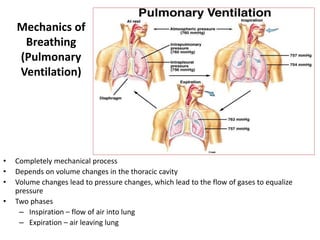
Mechanics_of_Breathing_(Pulmonary Ventilation)_Physiology_16-11-2018.pdf
- 1. Mechanics of Breathing (Pulmonary Ventilation) • Completely mechanical process • Depends on volume changes in the thoracic cavity • Volume changes lead to pressure changes, which lead to the flow of gases to equalize pressure • Two phases – Inspiration – flow of air into lung – Expiration – air leaving lung
- 3. Pressure Relationships in the Thoracic Cavity • Respiratory pressure is always described relative to atmospheric pressure • Atmospheric pressure (Patm) – Pressure exerted by the air surrounding the body – Negative respiratory pressure is less than Patm – Positive respiratory pressure is greater than Patm
- 4. Pressure Relationships in the Thoracic Cavity • Intrapulmonary pressure (Ppul) – pressure within the alveoli • Intrapleural pressure (Pip) – pressure within the pleural cavity
- 5. Pressure Relationships • Intrapulmonary pressure and intrapleural pressure fluctuate with the phases of breathing • Intrapulmonary pressure always eventually equalizes itself with atmospheric pressure • Intrapleural pressure is always less than intrapulmonary pressure and atmospheric pressure
- 6. Pressure Relationships • Two forces act to pull the lungs away from the thoracic wall, promoting lung collapse – Elasticity of lungs causes them to assume smallest possible size – Surface tension of alveolar fluid draws alveoli to their smallest possible size • Opposing force – elasticity of the chest wall pulls the thorax outward to enlarge the lungs. • Lymphatic system drains the pleural fluid, generating a negative pressure (- 5cm H2O pressure )
- 8. • The negative intrapulmonary pressure is what keeps the lungs from collapsing (atalectasis) due to their natural elasticity. • Any condition where Pip = Palv causes lung collapse. • The difference btwn Pip and Palv is the transpulmonary pressure. • Pneumothorax is the presence of air in the intrapleural space.
- 10. Lung Collapse • Caused by equalization of the intrapleural pressure with the intrapulmonary pressure • Transpulmonary pressure keeps the airways open – Transpulmonary pressure – difference between the intrapulmonary and intrapleural pressures (Ppul – Pip)
- 11. Pulmonary Ventilation • A mechanical process that depends on volume changes in the thoracic cavity • Volume changes lead to pressure changes, which lead to the flow of gases to equalize pressure
- 12. Boyle’s Law • Boyle’s law – the relationship between the pressure and volume of gases P1V1 = P2V2 – P = pressure of a gas in mm Hg – V = volume of a gas in cubic millimeters – Subscripts 1 and 2 represent the initial and resulting conditions, respectively
- 13. Inspiration • The diaphragm and external intercostal muscles (inspiratory muscles) contract and the rib cage rises • The lungs are stretched and intrapulmonary volume increases • Intrapulmonary pressure drops below atmospheric pressure (1 mm Hg) • Air flows into the lungs, down its pressure gradient, until intrapleural pressure = atmospheric pressure
- 14. Inspiration
- 17. Expiration • Inspiratory muscles relax and the rib cage descends due to gravity • Thoracic cavity volume decreases • Elastic lungs recoil passively and intrapulmonary volume decreases • Intrapulmonary pressure rises above atmospheric pressure (+1 mm Hg) • Gases flow out of the lungs down the pressure gradient until intrapulmonary pressure is 0
- 18. Expiration
- 19. Forced Expiration • Forced expiration is an active process due to contraction of oblique and transverse abdominus muscles, internal intercostals, and the latissimus dorsi. • The larynx is closed during coughing, sneezing, and Valsalva’s maneuver • Valsalva’s maneuver-Forced expiration against closed glottis . – Air is temporarily held in the lower respiratory tract by closing the glottis – Causes intra-abdominal pressure to rise when abdominal muscles contract. – Helps to empty the rectum. – Child birth .
- 21. Lung Compliance • The ease with which lungs can be expanded • Specifically, the measure of the change in lung volume that occurs with a given change in transpulmonary pressure • Determined by two main factors – Distensibility of the lung tissue and surrounding thoracic cage – Surface tension of the alveoli
- 22. Lung Compliance • A. Compliance of Lungs and Thoracic wall:0.13 liters/cm of H2O • B. Compliance of the Lungs only: 0.22 litre/cm H2O
- 23. Regional Lung Volume • In the upright posture: – Relative lung volume is greater at the apex – Lung is less compliant (stiffer) at the apex
- 24. Factors That Diminish Lung Compliance • Scar tissue or fibrosis that reduces the natural resilience of the lungs • Blockage of the smaller respiratory passages with mucus or fluid • Reduced production of surfactant • Decreased flexibility of the thoracic cage or its decreased ability to expand
- 25. Factors That Diminish Lung Compliance • Examples include: – Deformities of thorax – Ossification of the costal cartilage – Paralysis of intercostal muscles
- 26. Static Compliance Curves -18 -16 -14 -12 -10 -8 -6 -4 -2 0 2 Fibrosis (low compliance) Normal Emphysema (high compliance) VT FRCN VT FRCF VT FRCE Pleural Pressure, Ppl (cm H2O) Lung Volume
- 27. Surface Tension. – At every gas-liquid interface surface tension develops. – Surface Tension is a liquid property – LaPlace’s Law: P T r 2 P1 P2 T T r1 r2 T P r 2 P r 2 1 1 2 2 If r r Then, P P 1 2 2 1 Result: Small Bubble Collapses
- 31. Physiological Importance of Surfactant • Increases lung compliance (less stiff) • Promotes alveolar stability and prevents alveolar collapse • Promotes dry alveoli: – Alveolar collapse tends to “suck” fluid from pulmonary capillaries – Stabilizing alveoli prevents fluid transudation by preventing collapse.
- 32. Infant Respiratory Disease Syndrome (IRDS) • Surfactant starts late in fetal life – Surfactant: 23 wks 32-36 wks • Infants with immature surfactant (IRDS) – Stiff, fluid-filled lungs – Atelectatic areas (alveolar collapse) • Collapsed alveoli are poorly ventilated • Effective right to left shunt (Admixture)